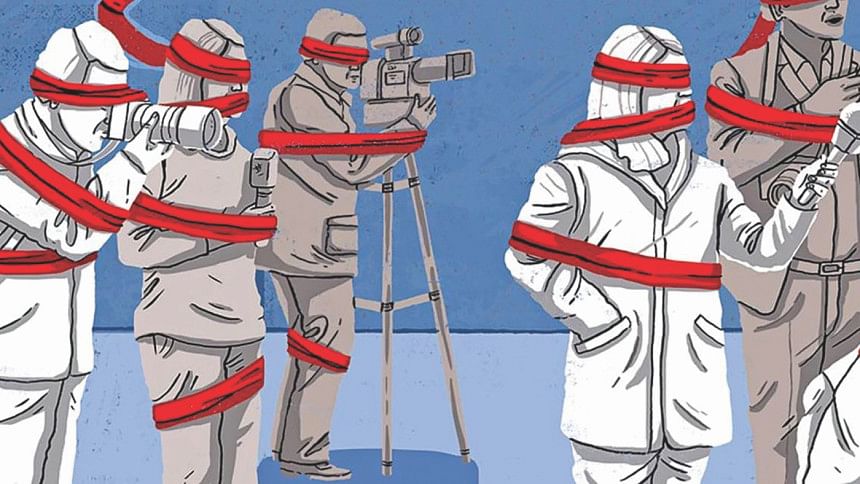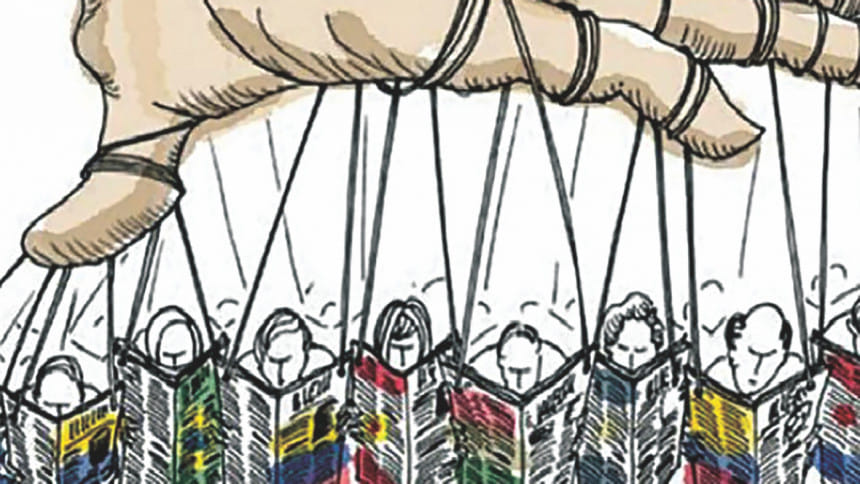Democratic backsliding and the information battle

Continued backsliding of democracy for more than a decade, globally and domestically, has raised the question—where are we heading? The question, for some, is an innocuous query, while for others it is the first step towards devising a strategy to halt the downward spiral.
The democratic backsliding, which began at least 13 years ago, is yet to hit rock-bottom although the Economist Intelligence Unit's 2019 report, published last month, shows a very complex picture. While the number of full democracies has increased by two countries in 2019—to 22; the number of autocracies has increased by an equal number, to 54. The overall picture is far from optimistic as less than six percent of the global population now live in countries with full democracies, and more than one-third of the global population are under an authoritarian system. While there wasn't any dramatic decline of democracy in the past year and we haven't experienced a spectacular event of complete collapse of a democratic system in any country, the status quo itself is a matter of concern.
The state of democracy in large countries, for example, the United States since 2016 and India since 2014, is extremely worrying; recent actions of the Modi regime in India and the continued efforts of the Trump administration in the US to undermine democratic institutions, create a chasm within the population and deliberately pursue the path of pernicious polarisation that portends more serious threats. Slight upward movement of a few countries within the hybrid regime category or the drop of two countries in the total number of hybrid regimes is not enough to conclude that the worst is over. It makes the question of the future trajectory more pertinent; is this the new normal?
Particularity of countries which have experienced the erosion notwithstanding, globally few common features of the process of democratic backsliding have emerged over the past decade. These characteristics include both institutional and non-institutional aspects. The institutional aspects have drawn significant attention in recent years. The manipulation of constitutional proviso of accountability leading to executive aggrandisement is an important element of the institutional aspect. That means power has increasingly been concentrated in the hands of the person who is at the helm of the executive branch—whether it is the president in the presidential system or the prime minister in the parliamentary system. Erica Frantz and Andrea Kendall-Taylor, in an incisive essay in 2017, noted that of the authoritarian shift between 2000 and 2010, a staggering 75 percent led to personalistic dictatorships. The executive aggrandisement has been made possible through establishing complete control over the legislative body. The legislative arm of the state, which was supposed to act as the source of checks and balances on the executive, has become a tool of the new authoritarianism.
A large body of studies on democratisation and its reversal, has shown that the electoral process is the first casualty and the first milepost of a downward spiral. Election is the principal mode of the new autocrats to emerge. Reports of Freedom House, EIU, Varieties of Democracy (VDem) and perceptive works of scholars of democratisation such as Larry Diamond, Thomas Carothers, Steven Levitsky, Daniel Ziblett have discussed this aspect at length. Neutering the opposition through legal and extra-legal measures and using the judiciary for this purpose is easily discernible.
As such, the phenomenon of backsliding is not limited to the present state of governance and its impact is not only restricted to the temporary loss of fundamental rights of the citizens; instead, it is making changes in the fundamental nature of the liberal state. This is particularly true for the hybrid regimes, the system which bears the traits of authoritarianism and democracy together. Often in the hybrid regimes, the boundary between the state, the government and the incumbent political party become blurred. State apparatuses act like a part of the party.
These institutional measures are coupled with control over freedom of expression and media. The new autocrats have adopted various legal measures and employed various strategies to establish a firm control over the mediascape (Ali Riaz, "How New Autocrats Curb Press Freedom," The Daily Star, November 29, 2019). Civil society organisations are targeted and decimated.
These measures help to raise and consolidate the powers of the new autocratic regimes all around the world. But increasingly scholars are asking the question as to how the new autocrats continue to survive and legitimise their existence, even when there is simmering discontent among the citizens. There is no single factor that can respond to the questions; "there is no silver bullet" so to speak, especially considering that new form of authoritarianism is an evolving phenomenon. Unlike the traditional autocrats, the newer reincarnations are more adept to the changes and in devising strategies. The survival of autocrats is dependent on a host of factors—coercion or a threat of coercion against the critics, ensuring pliant institutions, developing a veneer of legitimacy, co-opting various segments of society, to name a few. Drawing on the large number of instances, what has become more obvious is that one factor plays a crucial role: the control of information.
The control of the media is a part of the larger issue of controlling information. This effort must be distinguished from the typical mode of controlling the media with outright censorship or organised propaganda. The essential point of controlling information is establishing the legitimacy of the incumbent by highlighting the competency of a personalistic dictator, underscoring the worldview of the incumbent, and humiliating the critics, including the opponents. This phenomenon has emerged as a result of the access to internet of a large number of citizens all around the world. In the early stage of the proliferation of the internet and the rise of social media, it was described as the harbinger of democracy. But over time the new autocrats have awakened to the potentials of the internet to challenge the status quo and bring down the authoritarian regimes (Fahmida Zaman, "Where is thy freedom on the internet?", The Daily Star, 27 December 2019). Faced with this situation, there has been legal and extra-legal measures adopted by the authoritarian regimes which are described as "digital authoritarianism". Controlling the media and cyber space by the government is one aspect of controlling information.

However, perhaps the most effective measure to control the media has been the creation of a "digital army" under the command of the state or private entities and unleashing them to undermine the integrity of democracy and its related attributes such as tolerance. In the past decade, we have witnessed the rise of "troll army"—those whose job is to smear opponents, spread disinformation and post fake texts. While Russians have perfected this and used widely, including influencing the 2016 US election, it is not alone. The Chinese troll army is known as the wumao dang or "50 Cents Party", which reportedly has employed as many as two million people. According to one estimate, in China, 20 percent of all internet comments come from members of the "50 Cents Party". In recent months, the Chinese troll army targeted the Hong Kong protestors, especially women. Similarly, governments of Israel, Saudi Arabia, Turkey, Philippines and many others have built such kinds of operations.
It is not limited to the governments; political parties with little regard for truth and facts have used the tactics as well. For example, the troll army of Narendra Modi and BJP have wreaked havoc on Indian democracy through Facebook in 2014 and through WhatsApp in 2019. Giant social media, such as Facebook and WhatsApp, have been accused of manipulating elections in many places. A British parliamentary committee, in 2019, concluded with a damning verdict about Facebook: "A digital gangster destroying democracy" (The Guardian, February 17, 2019). According to Freedom House's "Freedom on the Net 2017" report, online manipulation and disinformation played influential roles in the elections in 18 countries.
The most important element of the troll army phenomenon is that they shape the discourse and the narrative. The narrative that is dished out is not always about the positive elements of the non-democratic forces but is also geared towards undermining the legitimacy of critical voices. They drown the voices of the opposition and inundate them with messages which sway public opinion. Sowing seeds of division on issues is one way, while there is another which sends the messages of depoliticisation. Disengagement of a larger population in politics only perpetuates the status quo, allow the autocrats to continue. Ranging from retweeting to commenting on each other's posts, the entire exercise is designed to create a dominant narrative which is more likely to be accepted by unsuspecting users of social media. These trolls not only decide the agenda of public discourse, it also pushes out the important issues and topics from discussions.
An example of the narratives of the authoritarian is their obsession with history. They attempt to rewrite history and create a single official narrative of history and protect this narrative through constitutional and legal measures. In so doing, they launch an open assault on academic freedom. Arch Puddington writes, "a number of countries have undertaken a refashioning of history to buttress the legitimacy and aims of the current government. Historians and journalists are forbidden to cross certain redlines set by the authorities."
The contents of these narratives, whether delegitimisation of the opponent, or fake news or praise of the autocrat or shaping selective historical narratives, are easy to reproduce, thanks to digital technology, and spread as if it has come from reliable sources. Undeniably, digitalisation has made this possible. When we speak of digitalisation, we should be cognisant of the fact that it is far from being technology. J Scott Brennen and Daniel Kreiss have rightly noted that digitalisation is a way, "in which many domains of social life are restructured around digital communication and media infrastructures." The temptation of digitalisation should not blind us to the downside of the technology. Without the necessary checks and balances, digitalisation has the potential to undermine privacy and fundamental rights. It has contributed to the growth of political participation and collective actions but also created opportunities for authoritarian regimes to limit the activism, create false narratives and hollow out democracy. Propagating hate, creating polarisation and contributing to the depoliticisation cannot be ignored when we celebrate digital technology and social media.
In the context of the ongoing democratic backsliding engineered by the incumbents in various countries and the use of digital technology to undermine the fundamental principles of democracy, we must devise the way forward. There are two things one must be mindful of. First, the institutions have been deliberately damaged to perpetuate the authoritarian rulers. The second element is the control over information. They are equally important. Therefore, the efforts should be working towards halting further damage to the fundamental institutions, and to confront the authoritarian regimes' attempts to establish control over information. Movement for democratic restoration perhaps should begin with the informational battle.
Ali Riaz is a distinguished professor of political science at Illinois State University, USA. His most recent book is "Voting in Hybrid Regime: Explaining the 2018 Bangladeshi Election" (Palgrave Macmillan, 2019).

 For all latest news, follow The Daily Star's Google News channel.
For all latest news, follow The Daily Star's Google News channel. 



Comments